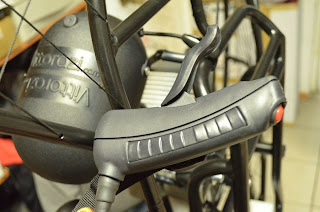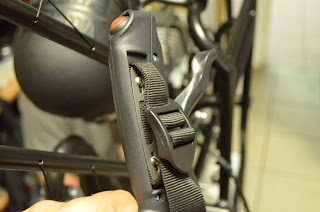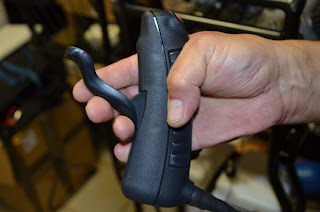Despite 30km/h wind last Saturday I had two flights in Woonona. Quite a few pilots arrived but some of them did not bother to set up the gear.
Short movie, enjoy!
Winter/windy paramotor Saturday from lukastu on Vimeo.
Sunday, 28 July 2013
Thursday, 25 July 2013
EC Extreme introduced new throttle handles
Paramotor Throttle handle
ECExtreme has introduced new throttle handle
New design is useful and can be used by both left and right handed pilots. Transition from one side to the other is as simple as readjustment of the holding strap.
Additionally the number of inner cables has been reduced to one. Now the outer part works also as the ground.
Spare cable can be used to plug RPM meter or other devices.
New shape is comfortable and easy to play with for pilots with either big or small hands.
The price for new throttle is ~$150 USD (450 PLN)
The kill switch is mounted in easily reachable place during the flight as well as on the ground.
Once new owner took care of the business, EC Extreme is working to improve pilots safety. Also website is being updated on more frequent basis.
EC Extreme
This article is a translation of Leszek's article.
Thursday, 18 July 2013
Reflex glider - how does it work - part 3/4
Why reflex airfoil is 'safe'?
The problem with the certification of the reflex wings is that the whole weight of the pilot and gear is equalised by the lift force generated on the leading edge of the airfoil. In this case it is very difficult to pull the collapse deliberately because even when the test pilot is pulling the A risers with his full weight he is not able to add more force upon them then his own weight acting on the risers.
This is the reason why reflex wings cannot pass the certification tests - they cannot be tested. The tests define how quickly and in what configuration the wing is coming out the deformations, not how easy it is to cause the deformation.
For example test pilot of Dudek Synthesis (and the author of the original text in Polish) was not able to cause 50% collapse on the full open trimmers so the wing could not pass the test.
Another thing is that in the wings with reflex airfoil the surface which is generating the lift force is much smaller in comparison to the classic airfoil. From this we can conclude that to equalize the pilots weight the effective wing load will be higher in comparison to the classic airfoils. And this is causing reflex airfoils to fly faster then the classic ones.
In the above picture we can see the lift force distribution on the reflex wing without speedbar (angle of attack 6 degrees )on the left hand side and with full speedbar on the right hand side (angle of attack 2 degrees).
We can see how the lift force moves forward with speedbar loading only A lines and making the wing more resistant to deformations.
In summary reflex wings are more stable, more resistant to deformations, faster. The downside is worse gliding ratio, certification is impossible in some configurations according to nowadays certification rules. Wing design is more complex as well.
The complexity in wing design are caused by the fact to control the glider we use trailing edge. When the pilot pulls the brakes the wing is lowering the trailing edge and the airfoil is not reflex anymore. In reflex mode the whole lift force is acting on the leading edge. When we pull the brakes (even a little) then lift force is also generated on the trailing edge. While not increasing the drag force enough it can cause a turn in the opposite way that pilot wants. For example we pull right hand brake in the reflex mode, additional lift force is generated on the trailing edge of the right wing (total sum of lift forces on the right half of the wing is higher then on the left), right wing is going up according to the increased lift force and we turn left. Normally this would be overcompensated by drag force generated on the right half of the wing (in classic airfoils) but in reflex mode the drag force can be not enough. In this way we can have left turn caused by pulling the right brake.
The other problem is that pulling the brake we kill the reflex airfoil characteristics which is causing the center of the pressure to move backward. This can result in wing tip collapses when pulling the brake even a little in reflex mode.
This is the end of part 3.
The author of the original text is Zbigniew Gotkiewicz. It was presented on www.paramotor.com.pl Leszek's blog
Thursday, 11 July 2013
RPM Meter - Spider MIni
RPM meter for paramotoring
Spider released mini RPM meter to paramotor engines (and other two stroke engines).
This device is not only measuring RPM it is also counting the current air time and total air time. Leszek have had this device for a few months. He has been testing it with different motors and now he decided to share his thoughts with us.
The RPM measurements look stable even when working with engines which generate severe electrical interference.
Specification:
- 6-15V Input
- 100-20 000 RPM range
- Number of impulses per rotation 2/1, 2/3, 3/1, 4/1
- Current airtime max 10h
- Total airtime max 1000h
- Size 34x90x13 mm
Two alarms are build in:
- When exceeding time of holding constant RPM
- When exceeding the total time limit
These two alarms can be used in different ways. First one can be used when we are running-in the engine. Second one can be used for servicing purposes like spark plug replacement etc.
Pros of this device:
- Long battery life (there was no need to replace the battery yet)
- Useful additional functionality
- Wide range of RPM
- Stable measurements
- Intuitive menu
- LED alarm
- small size
Installation is based on two steps. First one is to attach the device to the paramotor frame with zip-ties or double sided tape. Second step is to wrap spider's cable around the high voltage cable (spark plug cable).
The manufacturer claims that the device has been tested by different kind of users (quad riders, mini wind mill owners etc.). They reviews are good and the manufacturer is happy to support them.
This article is a translation on Leszek's Klich article.
Thursday, 4 July 2013
Reflex glider - how does it work - part 2/4
Why reflex gliders are safe?
Welcome to part 2 of the reflex airfoil
post series.
Despite the fact that a paraglider does not
have a tail there was no need to use reflex airfoils in our gliders. The center
of gravity is located a few meters below the canopy which makes the the whole system stable and the movements
of the center of pressure does not affect it that much.
The fact is that the reflex airfoil has a
much worse gliding ratio than a classic one. The other disadvantages are the
difficulties with controlling such a wing (deformations of the airfoil to make
a turn etc.)
Piotr Dudek was one of the pioneers in
applying reflex airfoils to paragliding. His idea was successfully popularized worldwide
by Paramania. Most paramotor pilots are flying reflex wings because they are
more resistant to collapses, and faster.
What makes the reflex airfoil so safe and
popular?
The airflow is most important above the
upper wing surface because this is the place where the most of the lift force
is generated.
The lift force in our case is caused by the
lower pressure on the upper part of the airfoil (blue area). The brighter the
blue, the lower the value of the
pressure. It makes the pressure difference between the upper and lower part of
the wing bigger.
From the above pictures we can conclude the
following for the classic airfoil:
- the lower the angle of attack, the lower the
lift force generated
- the lower the angle of attack, the more
the center of pressure is moving backwards
Reflex airfoil:
In the case of the reflex airfoil we can
see that even though the angle of attack decreased, the center of the pressure
did not move backwards. This makes the wing resistant to deformations and
collapses. The pressure to 'keep the wing open' is always there.
Another characteristic of the reflex is
that the area where the pressure is acting is smaller then in the classic
airfoil. Additionally it is located at the front of the airfoil so the
turbulence which is necessary to 'blow' this pressure out has to be stronger.
Another myth is related to the speed bar.
When pressing the speedbar we are decreasing the angle of attack. In reflex
wings the center of pressure is not moving backwards so the wing's collapse
resistance does not change.
What is important to keep in mind is that
if the deformation occurs on the full speedbar and opened trimmers, the result
will be very violent to the pilot due to higher speed.
This is the end of part two of this
article. Part three will be posted soon.
The author of the original text is Zbigniew Gotkiewicz. It was presented on www.paramotor.com.pl Leszek's blog
Subscribe to:
Comments (Atom)











